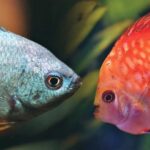Pine martens, with their agile movements, elusive nature, and undeniably cute appearance, often capture the hearts of wildlife enthusiasts. Belonging to the same family as weasels, otters, and badgers (Mustelidae), these creatures are found across Europe and parts of the Middle East, typically thriving in coniferous and deciduous forests. Their playful antics in the wild might lead some to wonder – could these captivating animals be kept as pets?
The Allure and Reality of Pine Martens
Pine martens (Martes martes) are indeed small and appealing animals, often compared in size to domestic cats. They typically grow to be between 25 to 31 inches long, including their bushy tail, and weigh a mere 2 to 5 pounds. Their silky brown fur, rounded ears, and distinctive yellowish-tan bib add to their charming appearance. It’s easy to see why someone might be drawn to the idea of having such an adorable creature as a pet.
However, beneath the cute exterior lies a wild animal perfectly adapted to its natural habitat. Pine martens are equipped with sharp, partially retractable claws, essential for their agility in climbing trees and hunting. These are not domesticated animals; they are inherently wild, with instincts and behaviors honed for survival in the forests.
Why Pine Martens Don’t Make Good Pets
While their size might be comparable to a cat, their temperament and needs are vastly different. Pine martens are known to be agile and even aggressive when necessary, traits vital for hunting prey like squirrels, mice, and small birds. Their diet in the wild is varied, ranging from rabbits and insects to berries and eggs, reflecting their opportunistic feeding habits.
Keeping a pine marten as a pet presents significant challenges:
- Legality and Ethics: In many regions, keeping a pine marten as a pet is illegal or requires special permits due to their protected status and wild nature. Ethically, removing a wild animal from its natural habitat for personal enjoyment is often questioned, especially when their conservation status might be vulnerable, as is the case in areas like Britain where they have faced population declines.
- Care Requirements: Pine martens have very specific needs that are extremely difficult to replicate in a domestic setting. Their natural behaviors include extensive roaming in forests, requiring ample space to climb and explore. Their diet is complex and ensuring they get the right nutrition in captivity would be challenging.
- Wild Instincts: Despite being raised in captivity, pine martens retain their wild instincts. They are not domesticated like cats or dogs, and their behavior can be unpredictable. Their sharp claws and teeth, essential for survival in the wild, can pose a risk in a household environment.
Appreciating Pine Martens in the Wild
Instead of considering them as pets, the true value of pine martens lies in their role within their natural ecosystems. Their hunting skills contribute to balancing populations of rodents and other small animals, playing a vital part in maintaining forest health. Observing these animals in their natural habitat, understanding their behaviors, and supporting conservation efforts is a far more rewarding and responsible approach.
In conclusion, while the idea of a pet pine marten might stem from their captivating charm, the reality is that they are wild animals unsuited for domestication. Their needs, both legally and ethically, are best met by allowing them to thrive in their natural forest homes. Appreciating them in the wild and supporting their conservation ensures these agile and elusive creatures continue to enrich our ecosystems.

